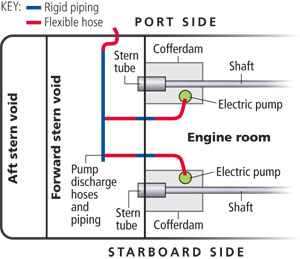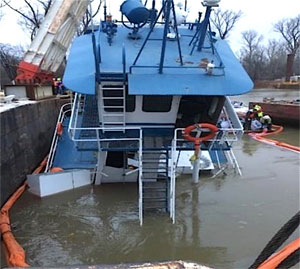Federal investigators have determined a fleet boat that flooded and sank near Dyersburg, Tenn., lost “watertight integrity,” most likely from inadequate maintenance.
Ms. Nancy C. sank March 6, 2018, at about 1630 in Everett Lake, a Mississippi River tributary, the day the towboat returned to service after a lay-up period. The National Transportation Safety Board (NTSB) said water accumulated in the aft stern void due to corrosion on the main deck.
Crew attempted to dewater the vessel but couldn’t keep up with flooding. The captain and deck hand escaped the towboat before it went down. More than 830 gallons of fuel and lube oils entered the waterway, and damage to the vessel exceeded $667,000.
“Investigators discovered numerous potential sources of water ingress on the main deck, in the engine room and in the voids,” the NTSB stated in an accident report. The agency said multiple aft hatch covers were not watertight, and there was widespread steel wastage around the deckhouse.
Ms. Nancy C., a 39-year-old fleet boat operated by Choctaw Transportation Co. of Dyersburg, went to work tending barges in Everett Lake at about 0600 on the morning of the incident. The vessel arrived at a company dock a day earlier after a lay-up period of several weeks.
Weather conditions were challenging, with winds gusting to 34 mph from the west and waves up to 4 feet with whitecaps, the report said. Ms. Nancy C. had two feet of freeboard, and investigators believe waves splashed on deck throughout the day.
The deck hand noticed water coming over the starboard side at 1600. He opened two hatches to the aft stern void and noticed the space was three-quarters full of water. He placed two electric submersible pumps within the space but found they were not keeping up with the flooding.
 |
|
A diagram of the boat’s cofferdam discharge system shows a hose passing through the main deck from the forward stern void, then through the port-side bulwark. “Investigators discovered numerous sources of potential water ingress on the main deck, in the engine room and in the voids,” the agency said. |
|
Pat Rossi illustration |
Shortly afterward, the deck hand and captain noticed the vessel was listing to starboard. They left Ms. Nancy C. to grab a gas-powered pump from a nearby work barge. Before they could return, the towboat sank at the stern in about 15 feet of water. Its bow remained tethered to the barge PBM413, owned by Pine Bluff Materials of Nashville, which was pushed into the west bank of Everett Lake.
Federal investigators inspected the towboat shortly after it was refloated on March 11, and again in dry dock. They identified steel wastage on and around the deckhouse where it met the main deck. One long section around the back of the house, from the port to starboard engine room doors, was of particular concern.
Although doubler plates were installed to address the corrosion, investigators said gaps remained that would have allowed water to enter the voids below. Openings between the aft and forward stern voids allowed water to move between them.
Leaking hoses from a pump used to remove water from a cofferdam under the port-side stern tube, as well as corroded unsecured access covers on deck, might have contributed to the flooding in the voids, investigators found.
“This quantity of water increased the stern trim and decreased the aft freeboard to a point where water on the main deck was able to freely enter the (two) open access covers to the stern voids, as well as through several other loose access hatches and poorly fitted doubler plates intended to cover holes created by deckhouse corrosion,” the report said.
“As the vessel sank further,” it continued, “water would then have entered the engine room through wastage on the aft side of the deckhouse and over the sills of the open engine room doors.”
Choctaw Transportation did not respond to a message seeking comment on the NTSB findings.

